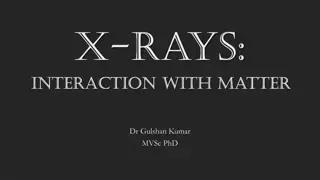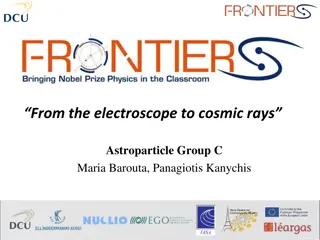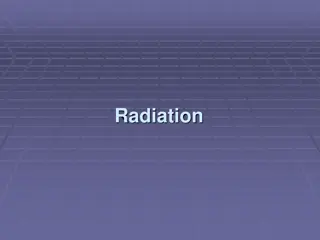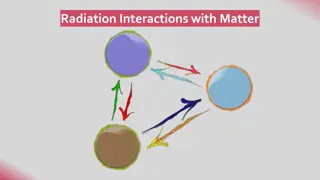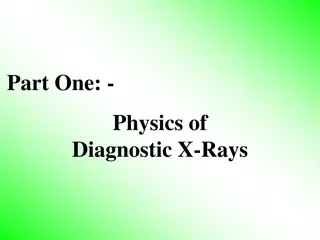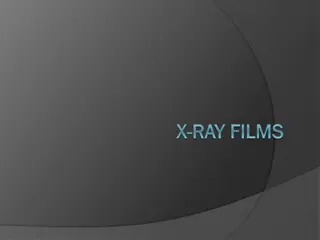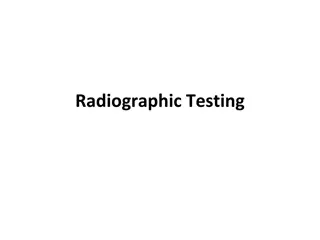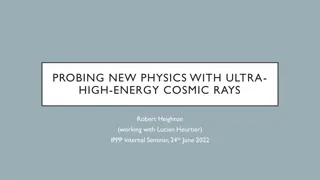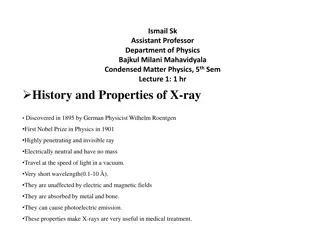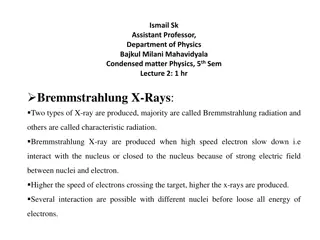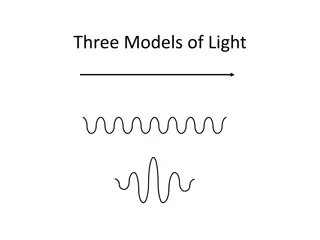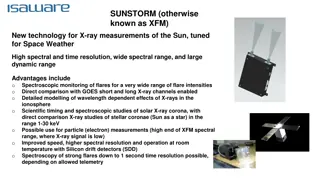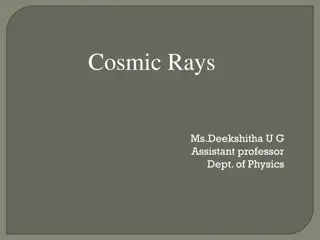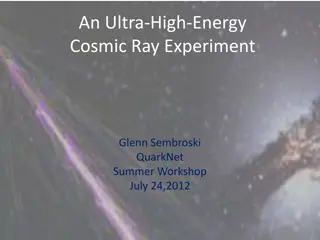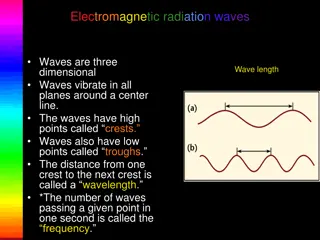X-ray Diffraction and Crystallography Safety Training Overview
X-ray diffraction and crystallography involve the use of ionizing electromagnetic radiation, specifically X-rays, which pose health risks if not handled properly. This training covers principles of X-ray safety, the importance of shielding materials like lead, steel, and concrete, X-ray production m
3 views • 44 slides
Understanding the Components of an X-Ray Machine
An X-ray machine consists of vital components like the x-ray tube, power supply, cathode, and anode. The x-ray tube houses the cathode and anode, which are responsible for generating x-rays. The cathode includes a filament heated to emit electrons, while the anode has a target to convert electron en
5 views • 22 slides
OBAGI Sun Shield Matte, dermsilk.com
Protect your skin complexion with OBAGI Sun Shield Matte Broad Spectrum SPF 50. It\u2019s for all skin types and contains Zinc oxide that deflects UV rays to prevent skin damage & aging. \/\/rb.gy\/3frlbx
1 views • 3 slides
Understanding Radioactive Decay and Nuclear Radiation
Radioactive decay is the process in which unstable atomic nuclei emit charged particles and energy, transforming into different elements. This process involves the emission of alpha particles, beta particles, and gamma rays. Alpha particles consist of two protons and two neutrons, beta particles are
4 views • 31 slides
Role of High-Resolution Computed Tomography in Fibrosing Interstitial Lung Diseases
HRCT plays a crucial role in diagnosing and monitoring fibrosing interstitial lung diseases (ILDs). It helps identify abnormalities not visible on X-rays, leading to early, accurate diagnoses and potentially avoiding invasive procedures. HRCT assists in distinguishing specific ILDs based on radiogra
1 views • 25 slides
Shop Tinted Sunscreen SPF 50 For All Skin
Uniqaya\u2019s tinted sunscreen has a broad spectrum formula with SPF 50, PA that protects you from both UVA and UVB rays. This sunscreen not only shields your skin from the sun but also from the harmful blue rays emitted from gadgets like mobile phones and laptops.
8 views • 3 slides
Embrace Cool Comfort - AC Installation in Vadodara and Gorwa
In the bustling streets of Vadodara and the serene corners of Gorwa, the sun reigns supreme, casting its fiery rays upon the land. In the midst of this relentless heat, there exists an oasis of cool tranquility \u2014 the humble air conditioner. As the summer heat bears down upon us, the need for re
2 views • 3 slides
Understanding Radioactivity and its Particles in Radiochemistry
Radioactivity involves the spontaneous decay of unstable atomic nuclei, releasing radiation in the form of alpha particles, beta particles, and gamma rays. Alpha particles are heavy and have low penetration, beta particles are light and faster, while gamma rays are high-energy waves with great penet
1 views • 20 slides
Understanding X-rays: Interaction with Matter in Diagnostic Imaging
X-rays, being photons traveling at the speed of light, interact with matter in various ways such as Coherent Scatter, Compton Scatter, Photoelectric Effect/Absorption, Pair Production, and Photodisintegration. These interactions involve exciting atoms, ionization, and energy transfer, influencing th
0 views • 9 slides
Understanding X-Ray Radiation: A Comprehensive Overview
X-ray radiation, discovered by Wilhelm Conrad Roentgen in 1895, is a high-energy electromagnetic radiation with a frequency range of 3.10^16Hz to 3.10^19Hz and a corresponding wavelength range from 0.01nm to 10nm. This form of radiation has applications in various fields, and its properties make it
0 views • 15 slides
Tinted Sunscreen SPF 50 For Sun Protection And UVA And UVB Rays
Uniqaya's broad-spectrum formula effectively blocks damaging UVA and UVB rays, preventing premature aging and sunburn. This tinted sunscreen is ideal for daily use and ensures your skin stays healthy, radiant, and protected all day. Shop Tinted Sunsc
3 views • 3 slides
Understanding Radiation Pollution and Its Sources
Radiation pollution is a serious environmental concern caused by both ionizing and non-ionizing radiation. Ionizing radiation, such as alpha and beta particles and gamma rays, can lead to cellular damage, while non-ionizing radiation, like solar radiation, can also impact living organisms. Sources o
0 views • 15 slides
Geometry Basics: Points, Lines, and Planes
Learn about the fundamental concepts in geometry such as points, lines, and planes, along with their characteristics and relationships. Explore undefined and defined terms, collinear and coplanar points, line segments, rays, and opposite rays.
3 views • 13 slides
The Discovery and Impact of X-Ray by Wilhelm Conrad Rontgen
Wilhelm Conrad Rontgen accidentally discovered X-rays in 1895, leading to a revolutionary way of seeing inside objects and the human body. X-rays are powerful electromagnetic radiations that penetrate matter and have diverse applications in medicine and industry.
0 views • 19 slides
Exploring Electroscope and Cosmic Rays in Science Education
This lesson pack delves into the construction and use of the electroscope, understanding static electricity, and detecting cosmic rays. Students engage in hands-on activities, explore the atom's structure, and learn about the interaction of particles with Earth's atmosphere. With a focus on inquiry-
0 views • 20 slides
Understanding Radiation and UV Rays: Risks and Impact
Radiation, in the form of waves or particles, can be ionizing and harmful. Ultraviolet (UV) rays from the sun, particularly UVA and UVB, can lead to skin damage, premature skin aging, and increase the risk of skin cancers. Protecting oneself from UV exposure and understanding the UV Index can help m
0 views • 28 slides
Ensuring Sustainability in Trade of Newly Listed Sharks and Manta Rays
Parties involved in the trade of newly listed sharks and manta rays must adhere to specific guidelines outlined by CITES Scientific Authorities to ensure the survival of the species. This includes obtaining non-detriment findings (NDFs) through scientific assessments, monitoring export permits, sett
2 views • 12 slides
Understanding Ionizing Radiation and Its Interactions with Matter
Ionizing radiation interacts with matter in direct and indirect ways, leading to various effects on biological systems. Directly ionizing particles disrupt atomic structures, while indirectly ionizing radiation like electromagnetic waves produce secondary electrons. Alpha particles have high ionizat
0 views • 22 slides
Understanding Ray Tracing in Computer Graphics
In the world of computer graphics, ray tracing plays a crucial role in rendering realistic images by simulating the behavior of light rays in a scene. This involves determining visibility, casting rays from a viewpoint, implementing ray tracing algorithms, computing viewing rays, calculating interse
0 views • 20 slides
Introduction to the Physics of Diagnostic X-Rays
The discovery of X-rays by W.C. Roentgen in 1895 was accidental, leading to a groundbreaking advancement in the field of radiology. X-ray photons are part of the electromagnetic spectrum and have applications in diagnostic radiology, radiation therapy, and nuclear medicine. The production of X-ray b
0 views • 30 slides
Understanding X-Ray Films: Composition and Classification
This detailed content explores X-ray films, covering elements such as emulsion, base foundation, supercoat, and protective layers. Learn about the intricate composition of X-ray film packets, the role of lead foil and black wrappers, and the classification of intraoral and extraoral X-rays like IOPA
0 views • 24 slides
Understanding Lenses: Types, Functions, and Rules
Delve into the world of lenses, exploring how they manipulate light rays using refraction. Discover the two main types of lenses - converging and diverging, and learn about their unique properties and focal points. Gain insights into the rules governing convex and concave lenses, and unlock the secr
0 views • 23 slides
Understanding Cosmic Ray Research: The Mysterious Knee in the Energy Spectrum
The energy spectrum of cosmic rays displays a unique power law behavior with distinct features such as the knee and the ankle. The knee, observed at around 3 PeV, marks a change in the spectral index. Various theories have been proposed to explain the origin of the knee, with suggestions ranging fro
0 views • 70 slides
Understanding Radiographic Testing: History, Science, and Radiation Safety
Exploring the history and science behind Radiographic Testing (RT), from the discovery of X-rays to the development of methods using gamma radiation. Learn about the terminology, natural radiation, and the characteristics of radiation in various forms. Understand the importance of safety measures in
0 views • 47 slides
Understanding X-Ray Diffraction Techniques in Materials Science
X-ray diffraction (XRD) analysis is a crucial technique in materials science for determining the crystallographic structure of materials. By irradiating a material with X-rays and measuring their intensities and scattering angles, XRD helps identify materials based on diffraction patterns. This meth
0 views • 5 slides
Unraveling the Mysteries of Ultra-High-Energy Cosmic Rays and Neutrinos
Delve into the exploration of ultra-high-energy cosmic rays and cosmogenic neutrinos in the quest to uncover new physics phenomena. Examining the GZK limit, cosmic accelerators, detection methods, and the potential for detecting tau neutrinos in Earth, this seminar presents a comprehensive overview
0 views • 28 slides
Exploring the History and Properties of X-rays in Condensed Matter Physics
X-rays, discovered by Wilhelm Roentgen in 1895, are highly penetrating rays with unique properties such as electrical neutrality, masslessness, and the ability to travel at the speed of light. They are valuable in medical treatments due to their absorption characteristics and ability to cause photoe
0 views • 4 slides
Understanding Bremmstrahlung and Characteristic X-Rays in Condensed Matter Physics
In condensed matter physics, Bremmstrahlung X-rays and characteristic X-rays are produced through different interactions of high-speed electrons with nuclei in target atoms. Bremmstrahlung radiation is generated when electrons slow down near the nucleus, while characteristic radiation is produced wh
0 views • 5 slides
Exploring Models of Light: Ray Model and Wave Model
This informative content delves into the Ray Model of Light, discussing how light travels in straight lines known as rays and how it can be made visible. It also explores the Wave Model of Light, covering topics like diffraction and the reasons why we often do not notice it. Additionally, the text t
0 views • 9 slides
Modern Physics Concepts in the 20th Century: Photons, Uncertainty, and Particle-Wave Duality
Modern physics in the 20th century blurred the lines between particles and waves, introducing concepts like photons, Heisenberg's uncertainty principle, and the dual nature of matter. Topics covered include the behaviors of electromagnetic waves, the photon concept, and the limitations of measuring
0 views • 23 slides
Introduction to Forensic Radiology: Techniques and Applications
Forensic radiology, as pioneered by Dr. Nashwa Mahmoud Mostafa, involves the use of radiographic techniques to assist in legal investigations and post-mortem examinations. Beginning with the historical overview of X-rays in forensic science, the field has evolved to utilize advanced imaging technolo
0 views • 68 slides
Exploring Vertebrates: Skeletons and X-rays
Dive into the world of vertebrates with a detailed exploration of their skeletons and X-rays. Discover the fascinating structures of frogs, snakes, lizards, birds, fish, humans, bats, dogs, dolphins, and even dinosaur fossils. Explore the intricate details through a series of captivating images, she
0 views • 18 slides
Understanding Radiation and Its Effects on Health
Radiation is a form of energy that can be emitted from radioactive materials in the form of particles or waves. It can be either ionizing or non-ionizing, with ionizing radiation having the ability to penetrate tissues and deposit energy within them. While alpha particles, beta particles, x-rays, an
1 views • 38 slides
Neutron Star Mergers and Ultra Heavy Element Cosmic Rays: Exploring Their Connection
Delve into the intriguing link between neutron star mergers and the synthesis of ultra heavy element cosmic rays. The rapid neutron capture process, known as r-process, plays a crucial role in creating elements heavier than iron through events like neutron star mergers and core-collapse supernovae.
0 views • 19 slides
SUNSTORM: Advanced X-ray Technology for Solar Measurements
SUNSTORM, also known as XFM, is a cutting-edge technology designed specifically for measuring X-rays from the Sun, tailored for Space Weather monitoring. It offers high spectral and time resolution, a wide spectral range, and a large dynamic range, making it ideal for various scientific studies rela
0 views • 4 slides
Understanding Cosmic Rays: Types, Effects, and Theories
Cosmic rays are high-energy radiation particles originating from outer space, bombarding Earth's atmosphere. They can be classified based on penetration power and experimental observations. The intensity of cosmic rays varies with latitude, altitude, and direction. The Van Allen radiation belts surr
0 views • 9 slides
Exploring the Mysteries of Ultra-High-Energy Cosmic Rays
Delve into the enigmatic world of ultra-high-energy cosmic rays, pondering questions about their origins, energy spectra, measurement techniques, and the intriguing Greisen-Zatsepin-Kuzmin cutoff mystery. Uncover the complexities of cosmic rays through a captivating journey of cosmic exploration.
0 views • 21 slides
Investigating Cosmic Rays with Student Researchers at Liceo Amaldi
A group of 40 students from Liceo Amaldi have been actively involved in the Extreme Energy Events project, studying cosmic rays and telescopic data. Utilizing software like Lazarus, Excel, and Root, they have analyzed the speed and angular distribution of cosmic ray muons. The students also went to
0 views • 19 slides
Solving Cosmic Gamma Background Anomaly: Ekaterina Shlepkina's Research Insights
Explore the quest to find a solution for the cosmic gamma background anomaly in cosmic rays through Ekaterina Shlepkina's research presented at the XXII International Workshop. Learn about the investigations into cosmic rays fluxes, antiparticle studies, and possible interaction types of Dark Matter
1 views • 19 slides
Exploring Electromagnetic Radiation Waves in the Universe
Electromagnetic radiation waves, including radio waves, microwaves, infrared, visible light, ultraviolet, X-rays, and gamma rays, play diverse roles in astronomy and technology. Understanding their properties, wavelengths, frequencies, and detection methods sheds light on their applications and sign
0 views • 11 slides








